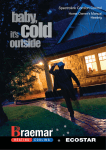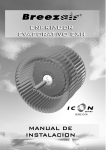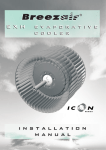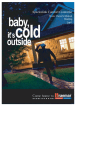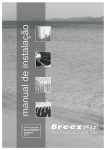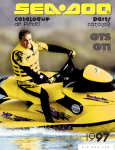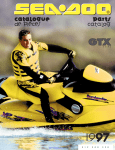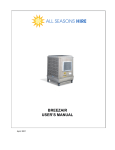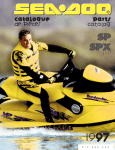Download Seeley BreezeAir ILL1140-A Installation manual
Transcript
Breezair EA Series Installation Manual Table of Contents ITEM PAGE ITEM General Safety Rules Employers and Employees Responsibilities 1 Other Important Requirements 2 Precautions 2 Unpacking the EA 2 Cooler Location and Orientation 2 Mounting the Cooler 3 Electrical Installation 4 Weatherdamper and Latch 5 Bleed-off Fitting 5 Water Installation 6 Water Level 7 Setting the Motor Current Pulley Adjustment Setting the Bleed-off Setting the Belt Tension 7, 8 8 8, 9 9 Setting the Motor Low Speed 10 Installation Checklist 11 Testing the Cooler 11 Evaporative Air Cooling Manual. Seeley International Pty Ltd, Adelaide, South Australia. A.C.N. 054 687 035. As the policy of the company is one of continuous product improvement, all specifications are subject to change without notice. 1 Employers and Employees Responsibilities The installation and maintenance of evaporative air coolers at high levels has the potential to create Occupational Health and Safety issues for those involved. Installers are advised to ensure they are familiar with the relevant State and National legislations, such as Acts of law, Regulations, approved Codes of Practice and Standards. Compliance with these regulations will require appropriate work practices, equipment, training and qualifications of workers. Seeley International provides the following information as a guide to contractors and employees to assist in minimising risk whilst working at high levels. INSTALLER AND MAINTENANCE CONTRACTORS A risk assessment is an essential element that should be conducted before the commencement of work, to identify and eliminate the risk of falls or to minimise these risks by implementing control measures. RISK ASSESSMENT A risk assessment of all hazardous tasks is required by law. This should be considered in terms of: • What are the chances of an incident happening? • What could the possible consequence be? • What can you do to reduce, or completely eliminate the risk? SOME POINTS TO CONSIDER • What is the best and safest access to the roof and working areas? • If a worker is alone, who knows they are there and if they get into difficulty, how can they summon help? (Call someone on the ground? Mobile phone? etc.) • What condition is the roof in? Should the trusses, underside or surface be checked? • Does the worker have appropriate foot wear? (Flat sole jogger type is advisable) • Are all power cables/extensions leads safe and appropriately rated? • Are all ladders, tools and equipment suitable in good condition? • Where ladders are to be used, is there a firm, stable base for them to stand on? Can they be tied or secured in some way at the top? • Is there a roof anchor to attach a harness and landyard to? If so, instruction should be issued for the use of an approved harness or only suitably trained people used. • Are all tools and materials being used, prevented from slipping and falling onto a person at ground level? Is the area below the work area suitably protected to prevent persons walking in this area? • Does the work schedule take into account weather conditions, allowing for work to be suspended in high winds, thunder storms/lightning or other types of weather giving wet, slippery surfaces? • Is there an on-going safety check system of harnesses, ropes, ladders and access/lifting equipment and where they exist on roofs, anchor points before the commencement of work? • Is there a system which prevents employees from working on roofs if they are unwell or under the influence of drugs or alcohol? 2 • Are there any special conditions to consider i.e. excessive roof pitch, limited ground area, fragile roof/walls, electrical power lines or a temporary power source? Other Important Requirements For lifting or pulling the cooler into position using ropes or slings, always apply the ropes around the blower housing. Never tie them to any or all of the four round corner posts. Never force parts to fit because all parts are designed to fit together easily without undue force. Never drill any holes in the primary base surface or side walls of the bottom tanks (reservoir) of the cooler nor in the side walls of the tank. Check the proposed cooler location, to ensure that it is structurally capable of supporting the weight of the cooler, or provide an adequate alternate load bearing structure. Air coolers installed at high levels on walls must have an adequate, safe platforms for maintenance personnel. Precautions Lifting and installing the Air Cooler is made easier by removing the cooling pad frames first. They can be replaced at the end of the installation procedure. You can slide the Air Cooler from one place to another if you wish but lifting and carrying is better. It is recommended that at least two (2) people carry the Air Cooler whenever it needs to be moved. Do not drop the Air Cooler. Always handle with care. Unpacking the Cooler Remove the external straps, cardboard and plastic bag. Remove a pad frame (Fig.2) to locate the accessories inside the cooler. Dispose of all the packaging wisely and in accordance with local regulations. Cooler Location and Orientation Check the proposed cooler location, to ensure that it is structurally capable of supporting the weight of the cooler, or provide an adequate alternate load bearing structure. Always locate the cooler where it will receive a plentiful supply of fresh air. Not in a recess where it may be starved for air or where the air is polluted. Ensure the location is a minimum of : 3 metres from a solid fuel heater flue, 1.5 metres from a gas flue, 5 metres from a sewer vent and 600mm from a wall. 3 Carefully consider neighbouring residences and noise levels when locating the cooler, if necessary talk to the customer and the neighbour before carrying out the installation. Mounting the Cooler DOWN DISCHARGE (See Fig. 3, 4, 5 & 6) Place the cooler as shown. Make sure the blower is facing in the correct direction to enable unobstructed air flow into the duct (Fig. 3). Check that the weatherdamper moves without obstruction. Fix the cooler to the vertical duct with the eight (8) self tapping screws provided (2 screws per side). If the vertical duct is firmly secured to the roof, any additional support frame for the cooler is not required. Screw length must be limited to a maximum of 1.5” (40mm) to avoid interfering with the weatherdamper. After securing the cooler, check for free operation of the weatherdamper over its full travel (see ‘Weatherdamper and Latch’ section - page 5). Always be sure that the air cooler is level after fitting on to the duct. SIDE DISCHARGE A mounting frame is required to be supplied by the installer. Always allow adequate space to remove cooling pads for cleaning. Always provide safety hand rails where necessary. Connect the cooler to the duct flexible connection on the side of the cooler. Always be sure that the air cooler is level after fitting on to the duct. TOP DISCHARGE A mounting frame is required to be supplied by the installer. Always allow adequate space to remove cooling pads for cleaning. Always provide safety hand rails where necessary. Always be sure that the air cooler is level after fitting on to the duct. 4 Electrical Installation Installation of the air cooler must conform to local electrical rules, regulations and standards. It is a requirement of Seeley International that all coolers be wired with a dedicated circuit to the distribution board. Each air cooler must have a separate fuse or circuit breaker. WARNING! Check to be sure that the voltage rating of the air cooler is compatible with your electrical system voltage. The Electrical Installation must be carried out by a licensed and qualified electrician. Sub-circuit wiring should be rated at 10 amps minimum or greater, depending on the rating plate data. The wall control is located in a convenient place inside the house or building to allow easy control of the air cooler functions. Prior to completion of the installation the electrician must check that the Air Cooler is operating correctly and must set the motor full load amps. Use a long type (or clip-on) ammeter to make the adjustments at the adjustable motor pulley. See later instructions. Electrical circuit wiring and its covering is to be continuous all the way into the junction box inside the cooler. The point of the entry into the cabinet of the air cooler is shown in Figs. 14, 15 & 16. Ensure that all electrical connections are tight. Loose connections cause overheating which can result in machine malfunction. Replace all covers. 5 Weatherdamper and Latch (Down Discharge Coolers only) The weatherdamper latch performs two functions (Fig. 9). In the locked position it acts as a transport latch preventing movement during transport. In the operating position it acts as a restrainer preventing gusts of wind from opening it. After the cooler is installed, squeeze the latch and rotate it clockwise to its operating position. Lift the latch and check by lifting the counter weight, that the weatherdamper flap is free to move. The counterweight should move freely through 90° (Fig. 10). Bleed-off Fitting A special plastic ‘bleed-off’ fitting is supplied with every air cooler. This has three functions. It acts as an overflow, a drain and a bleed-off. The bleedoff fitting comprises a small tray which collects water from under one of the cooling pads and drains this small quantity of water to waste. A large hole (50mm diameter) is pre-drilled in the base of the water reservoir (tank). The bleed off fitting should be installed at this position (Fig. 11). Make sure that it is correctly located in relation to cooling pad frame and that the large ‘O’ ring is on before placing it into the hole. The nut must be screwed up firmly by hand from underneath. It is a requirement of Seeley International Never drain the water directly on to the roof. Use a separate hose or pipe. Do not lose the ‘O’ ring supplied with this kit. Use of the bleed-off fitting is mandatory in order to protect the air cooler from excessive salt buildup and component failure. A special bleed stop cap is available for use in areas that prohibit bleed-off (Fig. 12 for fitting instructions). In this case all plugs in the bleed funnel must be removed as per diagram. This cooler may be supplied with an AUTO DRAIN KIT. If so, these instructions about bleed (above) remain in force. 6 Water Installation Installation of the air cooler water supply must conform to local plumbing rules, regulations and standards. The following specifications for water supply are required: Water Connections : Z\x " BSP Water Supply MAXIMUM : 800Kpa (115psl) The water connection point for down discharge air coolers is located on the underside of the water reservoir (tank) at the point where the float valve nipple protrudes from the bottom (Fig. 14). Install a manual shut off valve in the water supply line adjacent to the Cooler subject to local plumbing regulations. It is recommended to use a Z\v turn ball type shut off valve. This allows the water supply to be isolated whenever work needs to be done on the Cooler. DO NOT use a stop cock (faucet), i.e. a non-return type shut off valve. In areas subject to freezing, the water line needs a drain down facility. IMPORTANT! Flush the water pipe to remove any swarf before final fitting. NOTE! The float valve has a plastic threaded nipple for connecting to the water supply line. Do not overvalve, it is plastic. Use teflon tape on the threads and tighten carefully (Fig. 14). Always ensure that the supple pipe connection to the float valve does not place sideways strain onto the float valve. Run the pipe straight into the valve. Drain water from the overflow/bleed outlet must be carried away through a pipe to a suitable discharge point on the building or property (usually the drain or gutter). The pipe may be any material which will withstand direct sunlight and weathering. 16 7 Water Level Rotate the large float clockwise until it reaches the limit of its travel without coming off the arm (Fig. 14 page 6). Turn off the water supply and allow the water reservoir to fill with water. The float valve will eventually stop the water from entering the Air Cooler. Wait for this to happen and observe water level. Rotate the float around anti-clockwise a small amount to let more water in and observe the level. Continue the procedure until the water level remains at about 15mm below the top lip of the bleed-off tray. The water level should never be adjusted with the Air Cooler and pump running because the water in the filter pads will run back into the water reservoir and might overflow. Setting the Motor Current (Amperes) Important! The motor pulley and belt tension need to be adjusted to ensure that the motor is running at its rated capacity. If the current is set too low, the cooler will not perform to its optimum capacity, and the motor speed control may not work effectively. If the current is too high, the motor will overheat. It is most important that the motor current is set correctly. Before setting the motor current please ensure that: • All ducts and registers are in place. • Windows and doors in rooms to be cooled are open sufficiently, and • All cooling pad frames except the one on the motor side are in place. (1) Run the motor at maximum speed by operating the cooler from the wall control, in "MANUAL" mode, maximum fan speed, ventilation only. WARNING! Ensure that the pump is not running. (2) Continue running the motor for 10 minutes (warms up the motor) before proceeding with the current measurement. (3) Measure the motor current with a long type ammeter. Attach the ammeter around one of the motor cables inside the terminal box as shown (Fig. 17). 17 8 Compare the measured current with the rated current on the motor nameplate. If the measured current is less than, or greater than the rated current, the adjustable pulley should be altered accordingly. See heading "Pulley Adjustment" below. The measured current should be equal to, or within 0.5 amperes below that of the motor rated current. It must never be more than the rated current. Replace all covers and switch off clamp meter when adjustments are complete. Pulley Adjustment Important! Never attempt this adjustment with the air cooler operating. Pulley adjustment is made with the cooler power turned off at the switch inside the cooler. (1) Remove the drive belt. (2) To adjust the pulley: Remove the securing screw that holds the locking cap in place, then remove the cap. The adjustable half of the pulley is now free to be adjusted by rotating it on it's thread (Fig. 18). (3) To increase the blower speed and therefore increase the amps, the two halves of the pulley must be closer together, i.e. turn the adjustable half clockwise (pulley in). (4) To decrease the blower speed and therefore decrease the motor amps, the two halves of the pulley must be further apart, i.e. turn the adjustable half anti-clockwise (pulley out). (5) When an adjustment is made: Replace the locking cap, aligning the screw hole with the nearest hole in the adjustable sheave. Lock it into place with the securing screw. Refit the belt, ensuring tension is correct, (i.e. no slipping and not too tight, as this will effect the motor current) then check the amps. (6) Smaller adjustments should be made each time you approach the desired setting. See heading ‘Setting the Belt Tension' (Page 9). Setting the Bleed-off All Evaporative Air Coolers should be equipped with a bleed-off function which will reduce the level of salt build up in the water reservoir. The continuous bleeding of a small amount of water to drain ensures that fresh water is allowed in, to dilute the salt in the water reservoir. To set the bleed-off (Figs. 11 & 12 page 5) proceed as follows: 18 9 (1) Remove the cooling pad frame adjacent to the bleed-off assembly. (2) The bleed rate required will vary according to water quality, but should be set to the minimum rate as set out in the table below: EA 70.......0 plugs in. EA 90.......0 plugs in. EA 120.......1 plug in. EA 145.......1 plug in. EA 150.......1 plug in. Important! In poor quality water areas where the salt and mineral contents are high, adjust the bleed rate by inserting one or more extra plugs than specified in the table (more plugs in equals more bleed off). Note! Bleed adjustment cannot be precise, because operating conditions vary continually. Setting the Belt Tension 19 Note! This adjustment must be done immediately after the motor current adjustment has been completed. Belt tension is important, if it is too tight there will be excessive belt and bearing wear. If it is too loose there will be belt slip and excessive wear, accompanied with noise and loss of cooler performance. Note! Adjusting belt tension is not the correct way to alter motor current. The current can only be altered by adjusting the motor pulley. The belt tension should be adjusted so that the maximum deflection is 15mm-20mm when a reasonable force (approx 1.5kg) is applied (Fig. 20). There are two bolts for adjusting belt tension. These are located on the motor mounting plate. To make the adjustment, loosen the locking nuts on the two adjusting bolts on the motor mounting plate. Tighten or slacken the belt tension by screwing the bolts in or out respectively. When the adjustment is correct, tighten the locking nuts again. It is important to check the motor current rating again after making any alterations to the belt tension. This may require a further adjustment to the motor pulley, which may have been slipping, giving an incorrect reading. Correct belt tension ensures the belt will not slip. Check the temperature of the belt after running for 30 seconds following each adjustment. If the belt is warm to touch, then it is slipping. Continue tightening until the belt runs cool. 20 10 Motor Low Speed Setting EA variable speed coolers will function across a wide speed range. The minimum speed has been factory set, and should not require adjustment under normal circumstances. However, some adjustment may be necessary to suit each installation. After you have set the motor current and belt tension correctly, check the speed variation of the cooler. When the control is changed from maximum to minimum settings, there should be an easily recognizable difference in fan speed, not motor current. If there is not, check the following: (1) That windows and doors are open. (2) That the weatherdamper transport latch is undone and in the operating position. (3) That the weatherdamper is able to move freely. If the above are all correct then proceed as follows: (4) Turn the minimum speed adjustment knob (Fig. 21) clockwise or anti-clockwise, until the belt is running at approximately one revolution per second (this equates to a fan speed of approximately 600 rpm). Switch the fan off then on again, to ensure that it spins fast enough to open the weatherdamper and keep it open. It is important to allow the cooler to run for a while on minimum speed, to ensure the weatherdamper remains in the fully open position. 21 11 Installation Check List Check the following on initial start up: 1. Is the air cooler level? 2. Is the drain/overflow pipe installed? 3. Are all the roof or wall penetrations properly sealed? (i.e. ducts, electricity wiring, main supply water pipe, drain pipe, drain/overflow pipe) 4. Are there any water leaks in the water supply system? 5. Is the water level correct? 6. Is the electrical wiring properly grounded (earthed) at both ends? 7. Check that the Aspen pads are correctly in place, and there are no air gaps at the top of the pads due to movement in transportation. 8. Check that the galvanised wire pad securing frames are correctly positioned into all holes and clips. 9. Is the motor tightly mounted and secure? 10. Is the V-belt adjusted as specified? 11. Is the motor pulley tight on the shaft? 12. Is the motor pulley properly aligned with the fan pulley? 13. Is the pump running OK? Check by turning it on by itself. Does it wet all the filter pads? 14. Is the fan running in the correct direction? Should be clockwise when viewed from the pulley. 15. Does the fan operate at all speeds? 16. Was the fan motor current checked? 17. Has the owner been instructed in correct operation of the system and supplied with the owners manual? Testing the Cooler Once you are satisfied that the Cooler is installed and commissioned correctly, it is important to run the cooler and ensure that everything is working as it should. Check that the cooler runs quietly and with a balanced distribution of air to all outlets. Make sure there are no water leaks. Check the drain fittings and pipes, making sure there are no leaks. Clean up the Site Clean up and tidy the premises, removing all rubbish. Information extracted from Booklet 838373-E.













